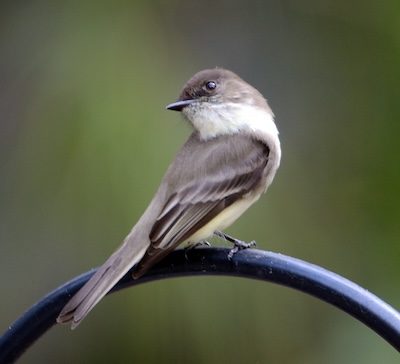
Pictured above is an Eastern Phoebe, a bird in the Tyrant Flycatcher Family. These small flycatchers have gray-brown upper-parts and slightly darker wings and tail. Their underparts are pale with a light yellowish wash on the belly, they have black bills, legs, and feet. They weigh 0.7 ounces, which is about the weight of two Bing cherries. They are 6 inches in length with a wingspan of 11 inches.
There are people who are somewhat unimpressed by this bird. They call Eastern Phoebes dull, drab or just ordinary birds because they are not brightly colored, like Painted Buntings, and don’t have fabulous crest feathers like Northern Cardinals. Personally, I think they are awesome! What these folks are missing are how beautiful they are and the many behaviors the phoebe possesses that sets them apart from other birds!



Feeding
Eastern Phoebes, unlike many other birds, forage using a “sit and wait” strategy. They patiently perch on a branch, twitching their tails up and down, waiting for a passing insect. When the prey is spotted, the phoebe launches off the branch and snags the insect in mid-air. These birds are very agile and are expert insect catchers. In addition to wasps, flies, ticks and spiders, these birds feed on small fish, fruits and berries.
Nesting
The Eastern Phoebe’s behavior of nesting is also quite unique, where females only construct the nest while males guard them against predators. The nest of an Eastern Phoebe are open cup-like and made out of mud, fine grass stems, moss and leaves. Their nests are protected from weather and predators by building under eaves, bridges and under building ledges. Unlike most birds, phoebes often return to the same breeding territory and sometimes even reuse the same nest. Eastern Phoebes typically lay 2-6 eggs and they produce two broods each year.
Eastern Phoebes are one of the few species that appear to have benefited from man-made changes to the landscape.
First Banded Bird in North America
John James Audubon, who was not only an artist but also a naturalist and ornithologist, was the first to band birds in North America. He loved to watch phoebes nesting in his Mill Grove, Pennsylvania yard, and in 1804, he performed the first bird banding study. He wanted to see if his Eastern Phoebes returned each year back to their place of birth to breed. John attached silver thread to the legs of five nestlings before they migrated. That next spring, he found two of the banded phoebes had returned and were nesting. This experiment proved John’s theory that Eastern Phoebe’s indeed returned to the same location of their birth to breed and nest.
Audubon’s banding experiment illustrated a phenomenon now called “site fidelity.” This term refers to the tendency of animals to return to the same nest site or breeding area and this behavior is common across many species, such as fish, birds, mammals and insects.
Today, Ornithologists still utilize bird banding to track animal migratory movements and identify population counts. Other technologies such as VHF radio, satellite and GPS tracking have also been utilized to track many animals such as wolves, sharks, butterflies, lizards and snakes.
Obtaining this information allows people to understand movement patterns, feeding habitat and other features related to the animal’s life history. The collected data plays a critical role in designing conservation plans and educational programs as well as identifying areas requiring further investigation. Increasing people’s awareness of animal’s habitat loss, water purity, abundance and/or quality.
Songs
Unlike most songbirds who must hear their parents and peer birds songs to perfect their own vocalizations, an Eastern Phoebe raised in captivity without other Eastern Phoebes will still sing the Eastern Phoebe song flawlessly! It’s quick call sounds as though they are saying their own name “fee bee.”
Migration

Eastern Phoebe flycatchers are a short to medium distance migrant. The map shows their breeding area to be eastern North America with wintering mainly in the southeastern United States, including Florida, Texas, Mexico and coastal South Carolina and Georgia.
Eastern Phoebes are the last to migrate south and first to return in the spring. On Seabrook Island, SC, we normally see them arrive in October and leave by the end of March.
Threats
Who preys on these birds? Phoebe’s main threats are snakes, mice, crows, and House Wrens. The Eastern Phoebe is a species of low conservation concern, having increased slightly in population between 1966 and 2019. According to the All About Birds website, “Historically, phoebes increased as people spread across the landscape and built structures the birds could use as nest sites.”
Our Eastern Pheobes in the South Carolina Lowcountry will be leaving soon for their nesting grounds in the west and to the north. I look forward to seeing them when I migrate north to Maine for my summer!
Article written by: Flo Foley
Photographs by Flo Foley & Dean Morr




FANTASTIC article! Loved this-
Ann Clark Preferred Properties Asheville 1270 Hendersonville Road Asheville, NC 28803 annclark@preferredprop.com 828 712-0033
Agency Disclosure: North Carolina REQUIRES that a real estate licensee must provide Agency Disclosure before providing property information. These are consumer protection laws that require us to provide you with Working With NC Real Estate Agents brochure, review it with you, and determine how you would like to be represented by your agent in your real estate transaction. https://www.preferredprop.com/realestate/agent/ann-clark/#agent-contact-61758
LikeLike
Flo, nice artic
LikeLiked by 1 person
Great article, such an under-appreciated birdie! Love to see them.
LikeLike
I love phoebes. They are so beautiful and their “song” is so distinctive. I look forward to seeing them every spring.
LikeLike